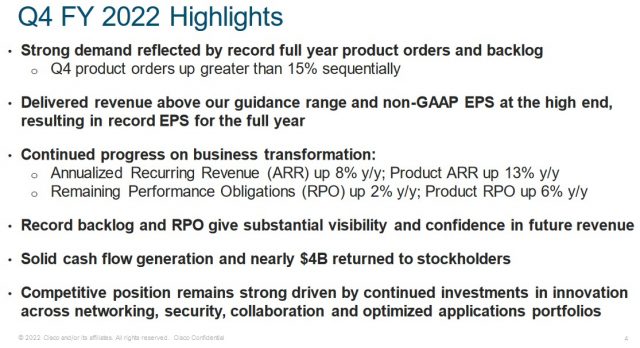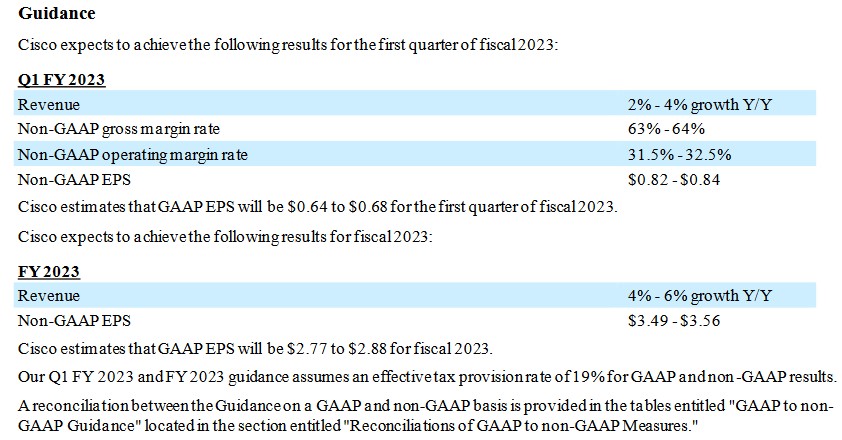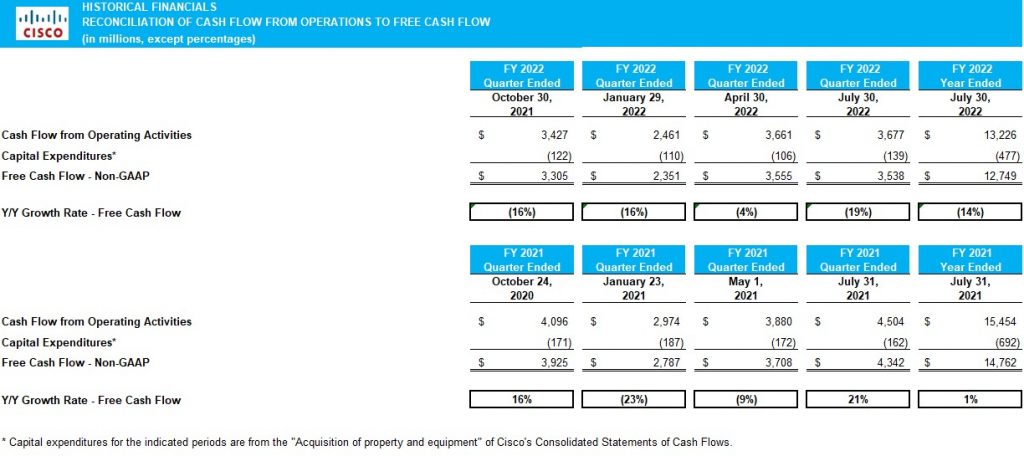Contents
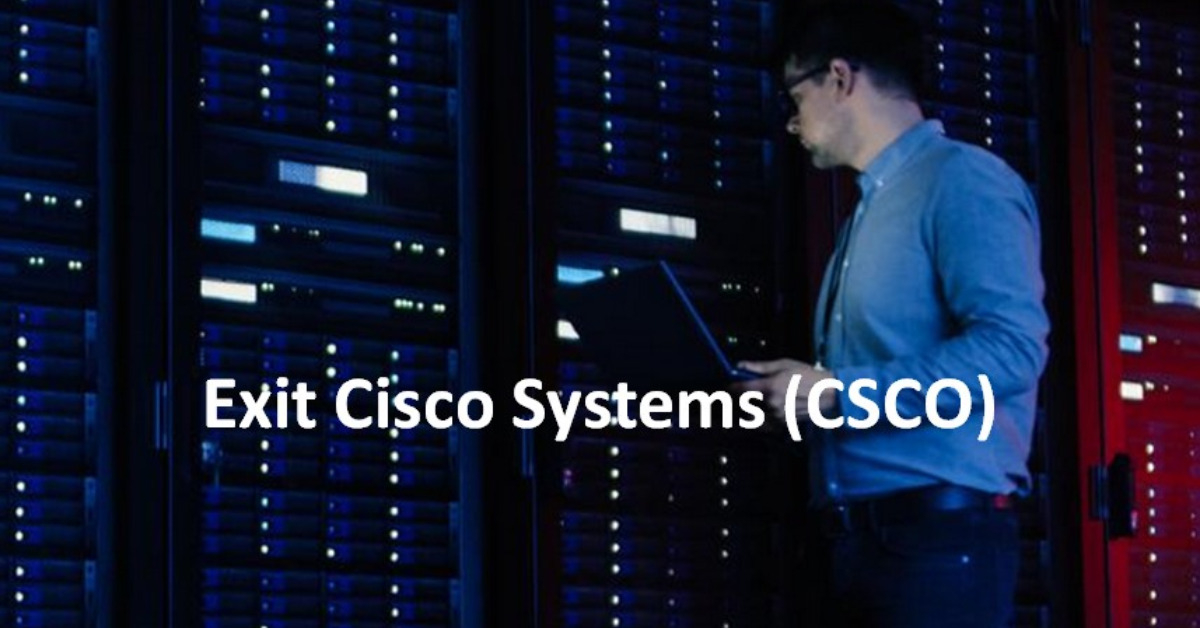
In my May 29, 2022 post, I recommend investors pass on Cisco Systems (CSCO) despite its attractive valuation. I now disclose my exit since there are companies that can produce superior long-term investment returns.
CSCO’s credit risk is acceptable but its top-line growth is negligible despite having spent over $12B on acquisitions in the last 5 fiscal years. Its FY2012 – FY2022 Annual Revenue (in billions) is $46, $48.6, $47.1, $49.2, $49.3, $48, $49.3, $51.9, $49.3, $49.8, and $51.6.
Looking at Note 4 – Acquisitions and Divestitures in the last several Form 10-K reports, the vast majority of the purchase price of various acquisitions has gone largely toward Intangible Assets and Goodwill. Very little has gone toward the acquisition of Net Tangible Assets.
On the bright side, CSCO’s:
- percentage of annualized recurring revenue is increasing;
- its credit ratings are investment grade;
- it is profitable; and
- annual free cash flow (FCF) is consistently strong thus enabling it to reward shareholders with share repurchases and well-covered quarterly dividends.
Despite CSCO’s attractive qualities, its total investment return over the past several years falls short of the S&P500 and the S&P Information Technology sector. I do not expect much improvement and thinkother companies can generate superior returns.
Although I exited my CSCO position on August 18, 2022, the following is a quick review of its Q4 and FY2022 results and FY2023 guidance.
Financial Results
Q4 and FY2022 Results
Please read CSCO’s Q4 2022 Earnings Release and Earnings Presentation. The FY2022 Form 10-K is unavailable as I compose this post.
CSCO recorded record product orders and backlog as well as its second most robust year of revenue in the history of the company at $51.6B. It also reported record net income.
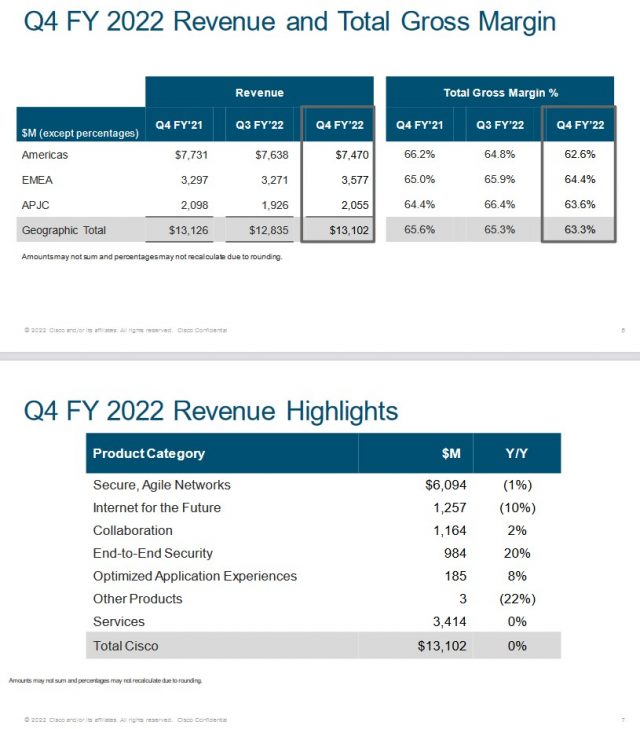
Source: CSCO – Q4 and FY2022 Earnings Presentation – August 17, 2022
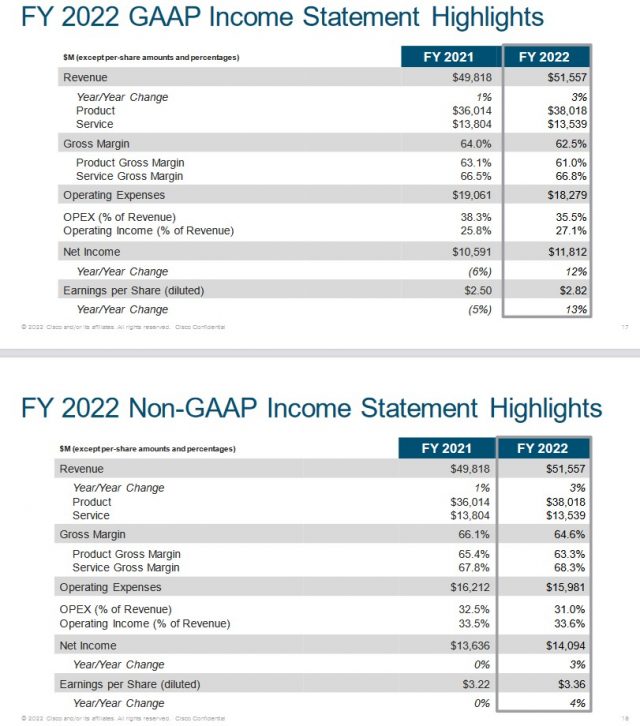
Source: CSCO – Q4 and FY2022 Earnings Presentation – August 17, 2022
On the supply front, CSCO continues to build greater resiliency. April was challenging due to the COVID-related shutdowns in Shanghai and the impact on semiconductor and power supplies. Overall supply constraints began to ease slightly at the back half of Q4 and the start of Q1 2023.
While the component supply headwinds remain, they have begun to show early signs of easing. Over the past two years, CSCO has been working to improve its resiliency and help offset cost inflation. This includes adding new suppliers, leveraging alternative suppliers, and redesigning hundreds of products to use alternative components with similar capability and targeted price increases.
CSCO continues to make progress on its transformation metrics as it shifts the business to more software and subscriptions.
Of CSCO’s total liabilities of $52.229B, current and long-term deferred revenue is $23.264B. Deferred revenue represents money received in advance from clients prior to the rendering of services. When we deduct deferred revenue from total liabilities, we get $28.965B in total liabilities. This is somewhat offset by total cash, cash equivalents and investments of $19.3B.
Operating cash flow in Q4 was $3.7B, down 18% YoY. This is primarily the result of advanced payments and inventory purchases to secure future supply.
In Q4, CSCO returned $4B to shareholders. $2.4B was in the form of share repurchases and $1.6B was cash dividends.
FY2023 Guidance
CSCO’s guidance is as follows.
Management expects strong performance across the portfolio in FY2023.
Some moderation from the unprecedented product order growth of last year, however, is anticipated.
Expectations are for higher costs in the short term, driven primarily by higher components, and freight and logistics costs. This margin pressure is expected to begin to ease as the year progresses.
Free Cash Flow
In FY2012 – FY2022, CSCO generated FCF (in Billions of $) of 10.37, 11.73, 11.06, 11.33, 12.42, 12.91, 12.83, 14.92, 14.66, 14.76, and 14.8.
There is certainly no issue with CSCO’s ability to consistently generate strong FCF.
Credit Ratings
CSCO’s long-term domestic unsecured debt credit ratings are unchanged from the time of my last review.
- Moody’s: A1 with a stable outlook (top tier upper-medium grade)
- S&P Global: AA- with a stable outlook (lowest tier high grade)
S&P Global’s rating is one notch higher than the rating assigned by Moody’s.
Moody’s rating defines CSCO as having a STRONG capacity to meet its financial commitments. It is, however, somewhat more susceptible to the adverse effects of changes in circumstances and economic conditions than obligors in higher-rated categories.
S&P’s rating defines CSCO as having a VERY STRONG capacity to meet its financial commitments. It differs from the highest-rated obligors only to a small degree.
Both ratings are investment grade and should be satisfactory for investors with a low tolerance for risk.
Dividend and Dividend Yield
CSCO’s dividend history is accessible here.
At the time of my November 4, 2021 post, CSCO shares were trading at ~$54.60. The $0.37 quarterly dividend yield was ~2.7%.
When I wrote my May 29, 2022 post, shares were trading at ~$45.60. The $0.38 quarterly dividend yield was ~3.3%.
Shares are now trading at $49.40 and the current dividend yield is ~3.1%. Since my CSCO shares were held in taxable accounts and I am a Canadian resident, I incurred a 15% dividend withholding tax. This reduces my dividend yield to ~2.6%.
Investors can expect two more $0.38 quarterly dividend payments (October and January). Following these 2 payments, I envision a $0.01 quarterly dividend increase. This is only a ~2.6% dividend increase which is well below the current rate of inflation.
Although I touch upon CSCO’s dividend metrics, it is preferable to look at an investment’s total potential investment return (capital gains and dividends). While there stands to be some capital appreciation from a CSCO investment, I think there are far better investment opportunities.
In FY2016 and FY2017, CSCO repurchased $3.9B and $3.7B of issued and outstanding shares. It followed up these purchases with the repurchase of $17.661B and $20.577B in FY2018 and FY2019 and $2.7B and $2.9B in FY2020 and FY2021. In recent years, it has also repurchased $0.5B – $0.9B of shares for tax withholdings on the vesting of restricted stock units.
Partially offsetting all these share repurchases is the issuance of common stock as part of the company’s employee compensation.
Putting together all these purchases and issuances of common shares over the years, we see a gradual reduction in the number of outstanding shares except for FY2018 and FY2019 when significant share repurchases occurred; the weighted average shares outstanding in FY2012 – FY2022 is 5,404, 5,380, 5,281, 5,146, 5,088, 5,049, 4,881, 4,453, 4,254, 4,236, and 4,192 (millions of shares). This was reduced to 4,137 in Q4.
In Q4 2022, CSCO repurchased ~54 million shares for a total of ~$2.402B at an average price of $44.02.
At the end of Q4 2022, ~$15.2B remained under the authorized repurchase program.
Valuation
In FY2012 – FY2022, CSCO generated diluted EPS of $1.49, $1.86, $1.49, $1.75, $2.11, $1.90, $0.02, $2.61, $2.64, $2.50, and $2.82. The weak FY2018 results are because of the enactment of the Tax Cut and Jobs Act (TCJA) on December 22, 2017. The TCJA significantly revised the U.S. corporate income tax by, among other things, lowering the statutory corporate income tax rate from 35% to 21% effective January 1, 2018, implementing a modified territorial tax system, and imposing a mandatory one-time transition tax on accumulated earnings of foreign subsidiaries.
Were it not for the enactment of the TCJA, CSCO’s FY2018 GAAP earnings would have been relatively consistent with that reported in recent years. However, because of the TCJA, CSCO’s PE based on GAAP earnings was 15.59, 12.68, 12.19, 18.92, 14.44, 14.46, 19.95, 139.77 (FY2018), 19.03, 18.12, 23.56, and 16.37 (source: Morningstar).
When I wrote my November 4, 2021 guest post, shares were trading at ~$54.60. CSCO’s FY2022 adjusted diluted EPS guidance was $3.38 – $3.45. Using the $3.415 mid-point, the forward adjusted diluted PE was ~16.
In addition, we had the following adjusted diluted PE levels based on the forward adjusted diluted guidance from the brokers which cover CSCO:
- FY2022 – guidance from 29 brokers was $3.37 – $3.50 with a mean of $3.43. The forward adjusted diluted PE was ~16 based on the mean value.
- FY2023 – guidance from 28 brokers was $3.55 – $4.02 with a mean of $3.67. The forward adjusted diluted PE was ~14.9 based on the mean value.
- FY2024 – guidance from 12 brokers was $3.70 – $4.10 with a mean of $3.87. The forward adjusted diluted PE was ~14.1 based on the mean value.
At the time of my May 29, 2022 post, CSCO shares were trading at ~$45.60. The following are the current adjusted diluted PE levels based on the forward adjusted diluted guidance from the brokers which cover CSCO:
- FY2022 – guidance from 25 brokers is $3.32 – $3.39 with a mean of $3.35. The forward adjusted diluted PE was ~13.6 based on the mean value.
- FY2023 – guidance from 25 brokers is $3.25 – $3.76 with a mean of $3.55. The forward adjusted diluted PE was ~12.8 based on the mean value.
- FY2024 – guidance from 13 brokers is $3.52 – $4.05 with a mean of $3.81. The forward adjusted diluted PE was ~12 based on the mean value.
Shares are now trading at $49.40. Using management’s FY2023 adjusted diluted EPS guidance of $3.49 – $3.56, the forward adjusted diluted PE range is ~13.9 – ~14.2.
The following are the current adjusted diluted PE levels based on the forward adjusted diluted guidance from the brokers which cover CSCO:
- FY2023 – guidance from 26 brokers is $3.41 – $3.68 with a mean of $3.54. The forward adjusted diluted PE is ~14 based on the mean value.
- FY2024 – guidance from 20 brokers is $3.52 – $4.04 with a mean of $3.79. The forward adjusted diluted PE is ~13 based on the mean value.
- FY2025 – guidance from 6 brokers is $3.91 – $4.17 with a mean of $4.02. The forward adjusted diluted PE is ~12.3 based on the mean value.
CSCO is a low-growth company hence the low valuation.
Final Thoughts
In previous posts, I indicate that I have been a CSCO shareholder since 2010. My book value is substantially below the current market price so any sale would trigger a capital gain. This would interfere with our tax planning strategies.
Over the years, my total exposure eventually reached 846 shares in one of the ‘Core’ accounts and 418 shares in one of the ‘Side’ accounts within the FFJ Portfolio. It has, however, never been one of my larger holdings. When I completed my Mid 2022 Investment Holdings Review it comprised only ~0.78% of my total holdings.
I typically acquire and hold shares. Lately, however, I have been looking to cull some non-core holdings. This has led me to exit companies for various reasons.
CSCO is a company I very rarely follow. With no intention of acquiring additional shares other than through automatic dividend reinvestment, I viewed it as an ‘exit’ position.
In hindsight, I should have exited my position when shares were grossly overvalued @ ~$60/share in December 2021. I didn’t and only ended up selling shares at ~$49.81 on August 18, 2022 so on 1246 shares I missed out on ~$12,700 ((~$60 – ~$49.81) x 1246) by not having been proactive. Fortunately, this is an insignificant value but it goes to show that selling at a decent price is just as important as buying at a decent price.
To somewhat offset the capital gains from the sale of my CSCO shares, I have exited my Verizon (VZ), AT&T (T), and Vontier (VNT) positions at a slight loss. None of these companies had been core holdings and each of them comprised an even smaller percentage of my total holdings than CSCO.
I made several investments during May – July. The proceeds from my recent sales replenish the cash available to acquire shares in some of my larger holdings.
I wish you much success on your journey to financial freedom!
Note: Please send any feedback, corrections, or questions to finfreejourney@gmail.com.
Disclosure: I have no exposure to CSCO and have no intention of acquiring shares in the next 72 hours.
Disclaimer: I do not know your circumstances and do not provide individualized advice or recommendations. I encourage you to make investment decisions by conducting your research and due diligence. Consult your financial advisor about your specific situation.
I wrote this article myself and it expresses my own opinions. I do not receive compensation for it and have no business relationship with any company mentioned in this article.


